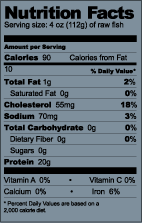
 |
North Atlantic Cod Scientific Name: Gadus morhua |
|
Black cod, True cod, Gray cod, Pacific cod, Polar cod, Alaska cod, Red cod, Ling cod... so many fish want to be cod because cod is so polular. But the cod that has earned this great reputation is the North Atlantic Cod, gadus morhua, also knows as Atlantic Cod. This specie is the benchmark to which all other white fleshed fish are compared. North Atlantic Cod The fillet of the Atlantic cod has all the attributes that make it the fish of choice for the fish 'n' chips trade both in Europe and the USA. It cooks up white, has large flakes and is both sweet and succulent. The flavour is mild and adapts well to a variety of cooking methods. Nutritional Information  Some things you should know about cod: Atlantic Cod vs. Pacific Cod Until the 1980's, cod was simply cod, invariably the North Atlantic Cod, or gadus morhua. But in the 80īs, the fishing of Pacific cod, gadus macrosephalus, started in earnest, and the fillet of this specie was also marketed as "cod". This is when difficulties with cod species arose. While the actual differences between these two species are few, they are important ones. The flesh of both species looks similar in fact, the Pacific cod is somewhat whiter than the Atlantic in the raw form, while both cook up equally white. The flavour of the two species is similar as well. It is the texture of the Pacific cod that lessens its value. Sometimes described as 'stringy', 'tough' and 'watery', it has less of the succulence and tenderness of the Atlantic cod. These attributes mark the Pacific cod as less desirable, and fillets and products of Pacific cod are lower priced than the same products of Atlantic Cod. The difficulties of both recognizing Atlantic cod from Pacific cod, and understanding the reasons for their different value, has been a recurring issue in the seafood industry. Attracted by the lower price, many buyers choose to minimise these subtle but importance differences, and to use Atlantic and Pacific cod interchangeably. While each cod specie has a legitimate place and value in the market, their differences are obvious enough to the consumer that the issue of consistency is raised every time a substitution is made. The Freshness Issue Fresh cod is better than frozen cod, but only when it is truly fresh. Getting fresh cod off the fishing vessel, through processing and packing, through the distribution system and into the mouth of the consumer while still truly fresh, is a very tricky process. On the other hand, frozen cod retains the freshness of the cod at the time it is frozen. Single frozen cod is frozen once. The once-frozen item is desirable in the trade, but like fresh fish, it often sounds better than it may actually be. Fish can be frozen on board freezing vessels, literally within a few hours of swimming in the ocean - and this is truly fresh fish. But it can also be frozen after spending many days in the hull of a fishing vessel - and be far from fresh at the time of freezing. Unfortunately, the fact that an item is single frozen does not give any true indication of its freshness. Twice frozen cod is frozen twice. Within hours of being harvested on freezing vessels, headed and gutted Cod is frozen as whole fish. This raw material is then transported to a processing plant in a 'fresh frozen' state. There it is tempered and thawed under controlled conditions, processed and then frozen a second time all within the same day. The twice frozen product is not only an exceptionally 'fresh' product, it is also a consistently 'fresh' product, as the freshness was locked in at the first freezing within hours of harvest. It is one day old fish - always! The Colour Issue In the raw state, the colour of the flesh of Pacific Cod is somewhat whiter than the colour of the Atlantic cod, which is slightly yellowish by nature. Both species cook up equally white. Twice frozen cod tends to be a bit darker in the uncooked state than single frozen cod, because, during the process of defrosting the frozen-at-sea raw material, kidney blood may tinge the flesh. However, twice frozen Cod cooks up just as white as single frozen or fresh Cod, and the flavour and texture are completely unaffected! The Cooking Issue Because it is so lean, cod cooks quickly. Cooking cod to perfection is a challenge, but the results are worth it. The trick is to undercook the cod slightly so the centre of the piece is still slightly raw or translucent. By letting the cooked fillet sit for a short time before serving, the heat in the flesh continues to cook the centre to perfection. The tendency to over cook cod can mean the difference between a delicious meal and an ordinary one. And here's another trick: Defrosting a frozen cod product fully before cooking results in moisture loss, called drip. This can reduce the succulence of the fish and effect its texture. It is best to cook the fish from a tempered state, ie. Just barely defrosted. Thin cuts of cod can be cooked most successfully from a completely frozen state. This way, all the natural moisture remains in the flesh, enhancing the flavour and texture. |